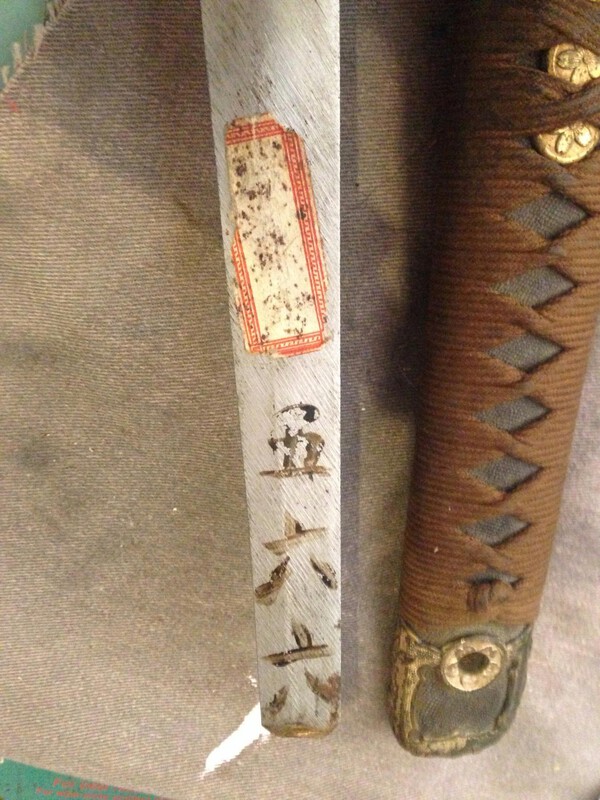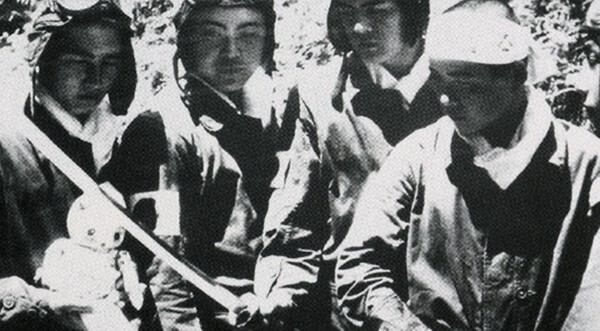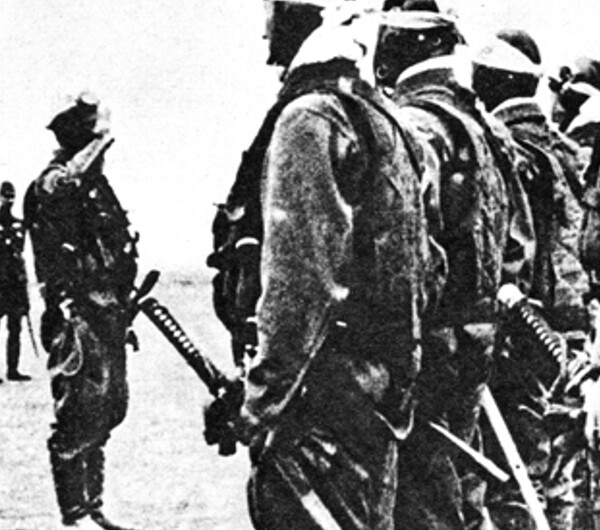-
Posts
12,932 -
Joined
-
Last visited
-
Days Won
154
Everything posted by Bruce Pennington
-
Josh, While the flaws may keep this from being as valuable, financially, as a blade in intact/original condition, you have something that is clearly a piece of history. Hopefully one of the guys who can do translation will let us know what the signature line says. The canvas covering under the silk wrap on the handle indicates that this was made late in the war (at least the handle was, can't speak for the blade itself). The all-brown officer rank tassel matches, as this style was adopted late in the war as well. This may very well have been something of a "re-build" done by a late-war sword company under pressure to produce swords, but suffered from lack of supplies. Welcome to the collecting world!
-

Showa Sword With "rutsubo Iron"
Bruce Pennington replied to Fuuten's topic in Military Swords of Japan
If you google the term, you'll find a 1973 patent application for a steel mold process, applied for by: "Original Assignee Nippon Rutsubo Kabushiki Kaish" Kind of goes along with what Stephen is thinking. -
I've noticed that too, Neil, but have never heard. It would be a question to put directly to a swordsmith I would think.
-
Fantastic! I have been told this style was designed by Takayama Masayoshi, who was an instructor at the Naval Academy in sword technique. His concept was developed after studying WWI trench warfare. The idea was draw, strike, kill with one blow. The more time spent hand-to-hand just increase the odds of someone else getting you from behind. So the blade is shorter, heavier, with more mass at the tip for more momentum. There are blades of this style signed by the smith as dedicated to Takayama, and called a Takayama-to. I've also discovered there was a "Takayama Prison" that was making war swords. So I don't know the actual source for our blades, but it's possible they were being made by the prison, or the style was just requested by the naval officer buying the sword. I've posted a couple of articles about Takayama below.
-
Is the other side unsigned? I have a navy gunto with the same Toyokawa Navy Arsenal stamp and the same sticker, unsigned. The blade is a bit different than normal, in the Takayama style with the fat kissaki tip, Looks like yours might be that way too?
-
Ed, the Anchor is the Toyokawa Naval Arsenal, the painted marks are for factory assembly, but the paper sticker is still a mystery. I have one that is just as unreadable, and have never seen one that is. Thanks for the pic!
-

Kamakazi Pilots With Civilian Swords
Bruce Pennington replied to Bruce Pennington's topic in Military Swords of Japan
A waki! I think the second pilot from the left, in the second pic at top, is carrying a waki, too. -
Stu W over at Warrelics wrote a very educational post about the Type 95 NCO you would enjoy reading: http://www.warrelics.eu/forum/Japanese-militaria/ija-type-95-nco-sword-info-228172/ The gunto in the picture above are NCO swords, not officer swords. Only officer gunto used real silk wrapping (ito). NCO gunto handles (tsuka) were metal except for the late '44-'45 versions that had wooden tsuka. The actual date of production of your sword is difficult to pinpoint, but could have been anywhere between 1938 and 1943.
-
There are a number of posts showing good pics of soldiers carrying civilian swords at war. I found these 2 going back through Ohmura's fabulous website. In the first shows a tsuba that is clearly non-military. The second has a flat-topped kabuto-gane.
-
Greg, This style was predominantly made by the Nagoya Aresenal, though I just recently saw one with a Tokyo 1st stamp. If you look by the serial number, there should be an inspector stamp and it will be either a Seki or a Nagoya. If you don't know what those are, post a good closeup and we'll tell you. As to "why" they did it - who knows - but personally I like the feel better of the side latch. When pulling a top-latch gunto out of the saya, your thumb is on top and your grip is a bit open until you can move your thumb back into position. With the side-latch your grip fully incircles the handle while unlatching and you never have to move it once the gunto is unsheathed. But I've never read their actual reasoning on the different style.
-

Indentification/information Request
Bruce Pennington replied to Philip's topic in Military Swords of Japan
Phillip, I've never heard how the dating system originated, wish I knew, but you do have to subtract 1 from the numbers after the emperor date. Ha, before the Showa era, previous emperor eras often used zodiacal kanji that added to the emperor era! You really need a decoder-ring to translate those! Well, even that isn't hard and fast. The Mantetsu factory used zodiacal dating on the Koa Issin blades, in the Showa era; while I've seen some old blades from earlier eras that had numberical dating too. So, you get a mix sometimes. Link with Zodiacal date chart: https://www.japaneseswordindex.com/kanji/zodiac.htm -

Yoshichika katana with REALLY Odd Stamp in English!
Bruce Pennington replied to Ed Hicks's topic in Military Swords of Japan
Steve, Long but educational discussion about this here: http://www.militaria.co.za/nmb/topic/4764-sword-markings/ Answer is still the same - Could be either! In that discussion the claim was made about the Seki stamp that only 1 of 100 Seki stamped blades will be gendaito. Examination is the only way to find out. -
Joe, Nick was quoting a Japanese polisher from a Japanese site. I didn't paste his entire discussion, and the previous paragraph discussed the non-traditional forging issue. What I found very interesting was the timeline - Seki-area smiths using Seki stamps on showato until "an arsenal" (Nagoya?) starts using the Seki too, so the smiths turned to using the Showa stamp. I have recently seen a 1944 Seki-smithed blade with a Nagoya stamp, dated Jan '44. I'm trying to get my head around the inspectors. I wonder if an inspector, say for Nagoya Arsenal, carried more than one stamp, say a Seki, a Nagoya, and a Showa? Or were there various levels of inspectors, some at Arsenal level, some at a Defense Ministry level (showa and star stamp) that worked all the arsenals? My questions came from reading one of Ohmura-san's pages where he shows a Showa stamp and the label underneath says "Department of Interior, ministry of ordinance stamp". Link to Warrelics discussion with Nick: http://www.warrelics.eu/forum/Japanese-militaria/showa-dept-interior-stamp-662590/ Link to Ohmura page: http://ohmura-study.net/211.html
-
An interesting update on some of the history of the Showa stamp, with a tad bit on anchor stamps from Nick Komiya on the Warrelics forum: "As to the origins for the mark, I understood that there were many cases of such mass produced blades snapping in the freezing cold weather of Manchuria. So the people in Seki decided to do voluntary impact testing on their products to ensure quality on blades for use by the military. They stamped blades that passed this test initially with the Kanji for Seki 関, signifying the guild. But later, one of the army arsenal factories happened to adopt the same kanji for marking, so the Seki people deferred and changed their impact test mark to the 昭 in cherry blossom mark for army orders and an anchor mark for navy orders. Anyway, that was what I took out from other sites."
-

Indentification/information Request
Bruce Pennington replied to Philip's topic in Military Swords of Japan
兼宗 (Kanemune) You're probably right on that! Peter, that one had me stumped but I think you're right: 名 Kanemune was a Seki smith, but Nagoya was the aresenal overseeing Seki production. Just never saw a Nagoya stamp on the nakago. Seeing new stuff (new to me!) all the time! -

Indentification/information Request
Bruce Pennington replied to Philip's topic in Military Swords of Japan
兼房 (Kanefusa) is my guess, but I wouldn't put much weight on that! -

Indentification/information Request
Bruce Pennington replied to Philip's topic in Military Swords of Japan
The date is January, 1944. Hopefully someone will translate the smith name. I'll see what I can do, but I'm new at the names. -

Indentification/information Request
Bruce Pennington replied to Philip's topic in Military Swords of Japan
Phillip, You have a Japanese Army Officer Type 3 Shingunto. You can read about them here: http://ohmura-study.net/952.html. Don't be afraid to take the handle off, it's made to come off easily, simply push the bamboo peg out from the others side. The handle will slip right off. If it's on tight I like to grab both sides of the hand guard and wiggle side to side, which scoots the handle back a bit and loosens it. Once you do, most likely there will be a swordsmith name on one side and a date on the other, all in Japanese of course. Take pics, blade pointed up, and post here for translation. This are usually dated from 1943 - 1945, but we'll see when you take it apart. -
Neil, you've got quite an excellent collection, don't you! There are a couple of guys on these forums who are real NCO experts and collectors. One showed a pic of some of his that included a late model painted all white for winter ops! I'm about to reach the point in saving my fun-money that I'm ready to buy my last NCO that I need to complete the set I've been building. All I need is the version 3, the Nagoya with side latch. I'll have to figure out what I'm going to do after that. I don't have all the late-war variants. Since they're getting more expensive it's probably time for me to go in that direction, since I seem to be unable to buy gunto at cheap prices! Your post challenged me to question what it is about WWII gunto that has my interest over nihonto in general. Partly it is because of a general fascination I have with WWII, but another part is that they feel more compartmentalized, more attainable that swords made over 1,000 years. That's just too vast for me. For the same reason, I like the NCO gunto. They are more specific and definable than officer gunto, which can vary considerably with custom fittings and ancient blades. Of course, after collecting for a couple of years, I was amazed to start realizing the seemingly endless variations of the NCO gunto! Ahhh!! Is nothing precise anymore???? Some of us need order!
-
Neil, Never seen that before either! The habaki is a higher quality, and with the little view we have of the fuchi, it appears pretty high quality too. It's possible this was a custom job with higher quality work which would account for the specialized koiguchi. Can't address the saya without more pics. There were uncovered wooden saya, but they were painted/laquered. Saya intended for leather covers usually had different ashi than uncovered ones. Pics will help. Looks like you've got another beauty.
-

Seki Inspection Tag On Combat Saya.
Bruce Pennington replied to mauser99's topic in Military Swords of Japan
You know, this subject is interesting enough, I wonder if we couldn't get it "stickied" or "pinned", as it's worth more investigation and discovery? -

Seki Inspection Tag On Combat Saya.
Bruce Pennington replied to mauser99's topic in Military Swords of Japan
Ha! Good reminder Dave! Never say never or always with WWII gunto! Good observation though, Shamsy! I wonder if the labels were something unique to Seki operations, or something initiated late in the war to try to keep quality from dropping too far? -

Seki Inspection Tag On Combat Saya.
Bruce Pennington replied to mauser99's topic in Military Swords of Japan
From the Japaneseswordindex, here is an example I was talking about. There are more like this, each with a different logo inside the Seki circle: Seki Hyaku Tan Sha Token Sei Saku Jo This company was located in Seki city. They offered a complete line of services, including old blades, newly made gunto, polishing, and koshirae. They also made gunto. -

Seki Inspection Tag On Combat Saya.
Bruce Pennington replied to mauser99's topic in Military Swords of Japan
Both these labels have the same circular Seki manufacturer logo. The circle is actually a stylistic "Se" over the top and "Ki" around the bottom, with the factory's logo in the middle. I am on the road and don't have my books so I don't know if this One is known. But the Seki area had quite a number of factories working and each one might have had their own logo. The label appears to be an inspection/approval and is called "rare" in the F&G book. http://forums.gunboards.com/showthread.php?651898-Have-you-ever-seen-this-before-on-a-wwii-Japanese-sword Here are two others recently posted: -

Seki Inspection Tag On Combat Saya.
Bruce Pennington replied to mauser99's topic in Military Swords of Japan
That's the third one I've seen in the last couple of weeks! Fuller & Gregory has a picture of one.










